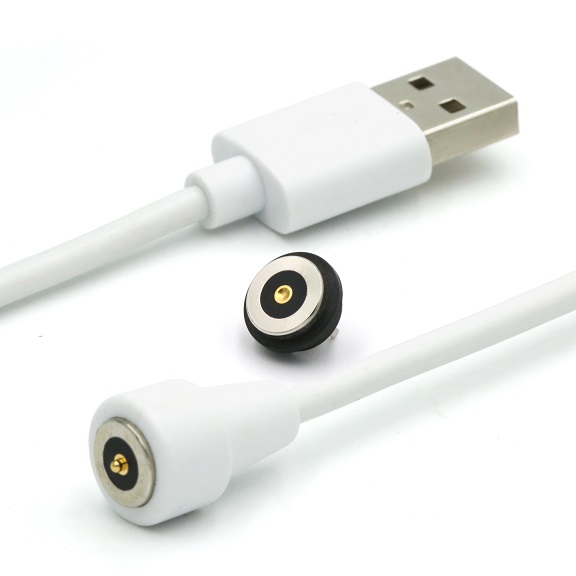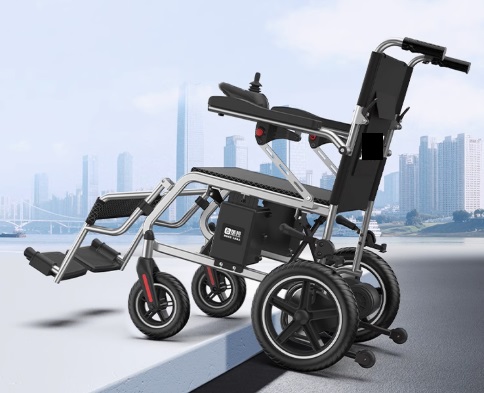Electric wheelchair uses magnetic Pogo pin charging cable solution

In the field of barrier-free travel, electric wheelchairs are the "second pair of legs" for people with limited mobility, and their energy supply method directly affects the user's independent quality of life. Traditional electric wheelchairs generally use plug-type charging interfaces, which have problems such as laborious plugging and unplugging, difficult alignment, and susceptibility to environmental interference. The magnetic Pogo pin charging solution not only solves the pain points of the traditional charging mode through the innovative design of "contactless docking + elastic conductivity", but also redefines the safety and convenience standards of electric wheelchairs and energy interaction.
Pain points and innovation needs of traditional charging modes
The charging interfaces of current mainstream electric wheelchairs are mostly DC round plugs or pin plugs, and these designs expose many problems in actual use. From the user operation level, people with limited mobility often have reduced fine motor skills of their hands. When plugging and unplugging the plug, they need to accurately align the interface and apply 5-8 Newtons of force, which is a significant obstacle for arthritis patients or people with spinal cord injuries. According to the survey data of a rehabilitation institution, 68% of electric wheelchair users have asked others for help due to difficulties in plugging and unplugging, and 32% of users have damaged the plug or interface due to improper operation.
In terms of safety performance, the exposed metal contacts of traditional interfaces are prone to short circuits due to rain, sweat or dust. In clinical cases, users have experienced battery swelling due to water ingress into the interface when charging on rainy days, and the interface wear caused by long-term plugging and unplugging will increase the contact resistance. The Joule heat generated during the charging process may cause local high temperature and pose a fire hazard. In addition, the rigid connection design between the traditional charging cable and the wheelchair is prone to interruption of charging due to dragging when the user stands up or moves the wheelchair, and even causes safety accidents such as equipment tipping over.
With the development of smart wheelchair technology, users' demand for intelligent and integrated charging systems has become increasingly prominent. Traditional interfaces can only realize a single charging function and cannot meet value-added needs such as battery health monitoring and charging status feedback. In this context, the magnetic Pogo pin solution has become the optimal solution to the above problems with its non-contact docking, multi-contact integration, and intelligent interaction.
The core design concept of the magnetic Pogo pin solution
The design philosophy of the magnetic Pogo pin charging system is based on the two principles of "barrier-free interaction" and "redundant safety". The solution consists of three parts: a charging socket installed on the side of the wheelchair armrest, a charging male head with magnetic positioning, and a charging cable with an integrated smart chip. This modular design not only ensures compatibility with the existing wheelchair battery system, but also reserves expansion space for future functional upgrades.
In terms of physical structure design, the R&D team adopted the "three-magnetic positioning + dual-contact redundancy" architecture. The charging socket is embedded with three NdFeB permanent magnets, which are distributed in a regular triangle, corresponding to the three opposite-polar magnets on the male head, forming an adsorption force of 15-20 Newtons. This magnetic field layout can achieve ±2mm alignment tolerance. Users only need to bring the male head close to the socket area to automatically complete precise docking under the guidance of the magnetic field without visual alignment. The surface of the socket is covered with a 0.3mm thick medical-grade silicone film, which not only ensures the penetration of the magnetic field, but also isolates water vapor and dust, reaching the IP65 protection level.
The contact design adopts a gold-plated Pogo pin spring pin structure. Each contact consists of a needle shaft, a spring, and a needle tube. The stroke is 1.2mm and can withstand more than 100,000 compression cycles. The dual-contact parallel design not only increases the rated current of a single contact from 3A to 6A, meeting the fast charging requirements of a 24V/10Ah battery, but also forms a redundant safety mechanism - even if one of the contacts fails due to foreign matter, the other contact can still maintain the charging circuit to avoid interruption. The inner wall of the needle tube is coated with nickel-phosphorus alloy, and the friction coefficient is reduced to 0.15. With the preload of the spring, it ensures that the contact remains in stable contact under vibration.
Function Implementation and Intelligent Interaction System
In addition to the basic charging function, the
magnetic Pogo pin charging cable solution has built a complete intelligent energy management system through the combination of hardware integration and software algorithms. The STM32F030 microcontroller built into the charging male plug monitors the battery voltage, charging current and ambient temperature in real time, and interacts with the main controller of the wheelchair through the I2C protocol. When the battery temperature exceeds 45℃ or the current fluctuates abnormally, the system will automatically cut off the charging circuit and send a red flashing alarm through the LED indicator on the armrest, and push information to the user's mobile phone APP.
In terms of charging efficiency optimization, the solution adopts a dynamic pulse charging algorithm. The charging curve is automatically adjusted according to the battery SOC (State of Charge) status: 0.5C constant current fast charging is used when the power is less than 30%, 0.3C balanced charging is switched to 30%-80%, and the last 20% is transferred to trickle charging mode, which not only shortens the charging time by 70%, but also reduces the battery polarization effect. Actual test data shows that it only takes 2.5 hours for an electric wheelchair equipped with this solution to fully charge a 12Ah battery, which is 40% more efficient than traditional linear chargers.
The system also has a unique "memory charging" function. By analyzing the user's charging habit data, the smart chip automatically identifies the commonly used charging time and issues a low battery reminder when the power drops to the preset threshold (default 20%). For elderly users with poor memory, the system can set a timed charging mode, automatically activate the charging program at a fixed time every day, and ensure that the wheelchair is always available.

Material process and environmental adaptability
In order to meet the complex use environment of electric wheelchairs, the solution implements strict standards in material selection. The Pogo pin contacts are made of high-purity oxygen-free copper by turning, and the surface gold plating layer is 0.8μm thick. After 48 hours of salt spray test, there is no corrosion phenomenon, ensuring the stability of conductive performance in a humid environment. The mother seat shell is injection molded with PA66+30% glass fiber reinforced material, with a wide temperature operating range of -40℃ to 85℃, which can adapt to the outdoor environment in northern winter and the high temperature environment in southern summer.
The charging cable is made of medical-grade TPU material, which is resistant to ozone and UV aging. After 5000 bending tests (bending radius 50mm), the electrical performance remains intact. The connection between the cable and the male connector adopts an integral injection-molded stress release structure that can withstand an axial tension of 150N, completely solving the problem of internal wire breakage caused by frequent bending of traditional charging cables.
In terms of electromagnetic compatibility design, the R&D team found through spectrum analysis that the Pogo pin contacts may generate electromagnetic radiation under high-frequency charging conditions. To this end, a nanocrystalline alloy magnetic ring and an EMI filter were added inside the female connector to control the electromagnetic radiation intensity below 30dBμV/m, which is far lower than the 54dBμV/m limit specified in GB9254-2008, ensuring no interference with medical auxiliary equipment such as pacemakers on wheelchairs.
Actual application scenarios and user experience upgrade
In field tests at community elderly care service centers, the magnetic Pogo pin solution showed a significant improvement in user experience. Aunt Zhang, a 75-year-old hemiplegic patient, said after using a wheelchair equipped with this system: "Now charging is as simple as magnets touching each other. There is no need to plug in the plug, and there is no need to worry about accidentally pulling out the charging cable when getting up at night." This design that does not require delicate operation has increased the proportion of users who complete charging independently from 32% to 91%.
For caregivers, this solution has greatly reduced the workload of care. Ms. Li, a nursing home nurse, reported: "In the past, we had to check whether the wheelchair was plugged in one by one. Now, as long as we see the indicator light turn green, we know that the charging is normal. In case of abnormal conditions, the system will automatically alarm and we can deal with it in time." The intelligent management function reduces the nursing time related to charging by 60%, and caregivers can devote more energy to the user's rehabilitation training.
In special environment applications, the advantages of this solution are more prominent. In rainy southern cities, the IP65 protection level ensures that the wheelchair is not afraid of rain when charging outdoors; and in scenes such as hospitals that require frequent disinfection, the charging base can withstand repeated wiping with 75% alcohol without affecting the magnetic properties and conductivity. The usage records of a rehabilitation hospital show that after adopting this solution, the failure rate of the charging system of the electric wheelchair has dropped from 4.2 times per month to 0.3 times, and the battery life has been extended by 1.5 years.
Industry standards and future evolution direction
The promotion of the magnetic Pogo pin charging cable solution is promoting the formulation of industry standards. At present, the China Center for Assistive Devices for Persons with Disabilities has included this solution in the revised draft of the "Technical Specifications for Intelligent Wheelchairs", and has put forward recommended requirements for key parameters such as magnetic strength, contact spacing, and communication protocols. The industry association is taking the lead in formulating cross-brand compatibility standards. In the future, users are expected to use the same charger to charge electric wheelchairs of different brands to solve the problem of accessory universality.
In terms of technological evolution, the R&D team is exploring three innovative directions: first, combining wireless charging with magnetic positioning, realizing non-contact charging within a distance of 5cm through magnetic resonance coupling, and completely eliminating physical contacts; second, developing a flexible Pogo pin array to adapt to the installation requirements of wheelchair surfaces with different curvatures; third, integrating NFC near-field communication functions to achieve charging permission management and prevent unauthorized charging. These technical reserves will enable the charging system to evolve from a simple energy transmission tool to an intelligent node that connects users, devices and services.
The value of the magnetic Pogo pin charging solution lies not only in technological innovation, but also in its profound practice of the concept of barrier-free. When charging, a daily behavior, is no longer an obstacle, electric wheelchairs can truly become an extension of users' free travel. This "people-oriented" design thinking is driving the entire assistive device industry from "functional satisfaction" to "experience upgrade", building a more dignified and autonomous lifestyle for people with disabilities and the elderly.
Author: Jerry_shi

